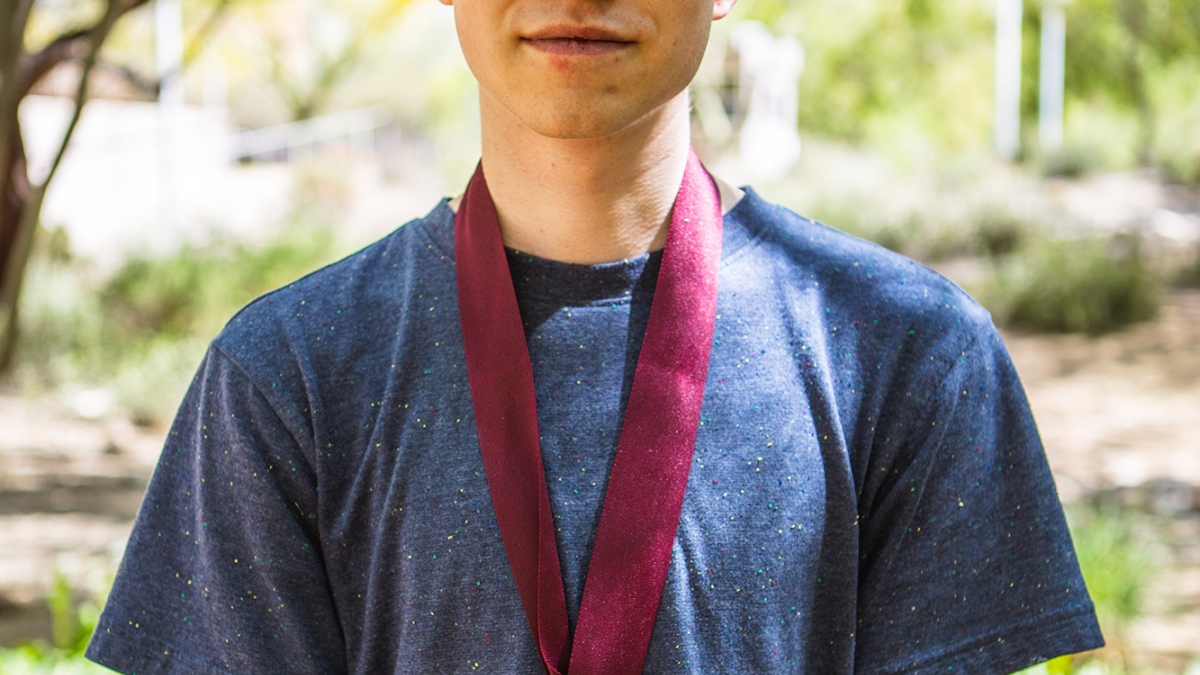Dean's Medalist discovers creativity and mathematics go hand in hand

Benjamin Jones is the spring 2021 Dean's Medalist for the School of Mathematical and Statistical Sciences.
Editor's note: This story is part of a series of profiles of notable spring 2021 graduates.
Andrew Bremner has worked with many talented students over his 30-plus years as a professor of mathematics at ASU. One day last spring while waiting for his intermediate abstract algebra class to start, he posed to those present a problem of the “self-referential” number in base 10 — namely to find a unique 10-digit number whose first digit indicates how many times 0 appears in the number, the second digit indicates how often 1 appears, down to the 10th digit giving the total appearances of the number 9.
Two days later, a student presented his analysis of the problem for a general base, classifying all such “self-referential” integers. That student was Benjamin Jones, the spring 2021 Dean’s Medalist for the School of Mathematical and Statistical Sciences.
Over the next couple of weeks, Jones wrote up his findings in rigorous mode for submission to an undergraduate mathematics journal, but sadly, they discovered in a detailed literature search that the results had already been published, albeit in a relatively obscure location.
In the meantime, Jones asked Bremner to serve as the director of his Barrett, The Honors College thesis. Over the summer, Bremner had him read through the undergraduate Silverman and Tate book on elliptic curves, and posed him the number theory problem of finding integer points on elliptic curves. The current knowledge was curves with 140–150 integer points. Jones was able to find examples with 272 points.
“Not only did Ben break the record — he smashed it,” said Bremner. “As far as I know, he is the current world record holder.”
Jones posted his thesis on the math arXiv, where it has received quite a bit of interest. Colleagues with whom Bremner shared the thesis were impressed.
“He showed initiative and enthusiasm. It was a pleasure to work with him,” said Bremner.
Jones graduates this spring with a Bachelor of Science degree in mathematics and a certificate in cryptology. He has an outstanding cumulative GPA of 4.02, achieved with many challenging graduate level courses.
In addition to his own academic successes, Jones served as an academic success tutor as well as a grader in mathematics, and provided help for other students.
He had two internships in data engineering with Tile, Inc., a company that makes low-power Bluetooth tracking devices, and an IT security internship with AAA Insurance. In 2019, his team was awarded Best in Show during the ASA DataFest competition.
In his free time, Jones enjoys writing software, such as fractal renderers, compilers and lots of calculator games, which he posts to his github account and his personal website. He recently made a proof assistant, a programming language that verifies proofs and comes with a model of the Zermelo-Fraenkel set theory axioms and appropriate proofs to show that definitions are well defined.
After graduation, Jones plans to continue his studies toward a PhD in mathematics. We asked him to share about his journey as a Sun Devil.
Question: Why did you choose ASU?
Answer: I have a lot of family in Phoenix, and I wouldn’t have been able to afford going out of state. With a larger school comes more people and more diversity, too! I like the various advantages of this, and especially the fact that ASU has so many student organizations.
Q: What was your “aha” moment, when you realized you wanted to study the field you majored in?
A: There were two “aha” moments. The first one was when I was in fifth grade. I was enjoying learning how to program computers, and somehow everything I was learning was teaching me how to think like a mathematician as well.
The second “aha” moment was when I was taking (MAT 300) Mathematical Structures with Dr. Childress during my freshman year. The name of the class seemed vague enough that I had no expectations for what I would learn. Everything surprised me and gave me a new perspective on what mathematics actually is. This class embodied the parts of mathematics that before I didn’t realize were the parts I liked!
Q: What do you like most about mathematics (and your area of concentration)?
A: I like that mathematics is the only subject that requires one to be so rigorous yet so creative at the same time.
Q: What is something you learned while at ASU — in the classroom or otherwise — that surprised you, that changed your perspective?
A: Sometimes it seems like people think experts are born experts, but nobody is. It’s clear to me that my professors have worked very hard to become who they are. And even they occasionally must re-derive a result they forgot, so nobody should be intimidated by not understanding something.
Q: What is the best piece of advice you would give to those still in school?
A: Make sure you enjoy how you spend your time!
Q: What was your favorite spot on campus, whether for studying, meeting friends or just thinking about life?
A: I like to skate around campus, and there is an especially nice garden by the Biodesign buildings.
Q: What do you think is most misunderstood about math by the general public?
A: MATHEMATICS IS CREATIVE!
More Science and technology

ASU-led space telescope is ready to fly
The Star Planet Activity Research CubeSat, or SPARCS, a small space telescope that will monitor the flares and sunspot activity…

ASU at the heart of the state's revitalized microelectronics industry
A stronger local economy, more reliable technology, and a future where our computers and devices do the impossible: that’s the…

Breakthrough copper alloy achieves unprecedented high-temperature performance
A team of researchers from Arizona State University, the U.S. Army Research Laboratory, Lehigh University and Louisiana State…

